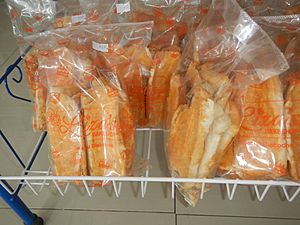Biscocho facts for kids

Biscocho de caña
|
|
| Alternative names | Biskoto, Biscocho duro, Machacao, Matsakaw |
|---|---|
| Type | Bread |
| Place of origin | Philippines |
Biskotso (pronounced bis-KOH-choh) is a popular Filipino snack. It's a type of bread that's baked twice. This makes it super crunchy! Often, it's coated with sweet butter and sugar. Sometimes, it even has a savory garlic flavor.
Many people think of biskotso from Iloilo province. But you can find different kinds of biskotso all over the Philippines. It's also known by other names like biscocho duro, machacao, or matsakaw.
Contents
The Story of Biskotso
The word biscocho comes from the Spanish word bizcocho. However, they are not the same kind of food. The Spanish bizcocho is a soft sponge cake. In the Philippines, this soft cake is called broas.
The crunchy, twice-baked biskotso we know in the Philippines is unique. It's not found in Spanish cooking. Different regions in the Philippines have their own stories about who first made biskotso.
Different Kinds of Biskotso
There are many types of biskotso across the Philippines. People usually just call them "biskotso," which can be a bit confusing. A cool thing about most biskotso is that they are often made from bread that's a bit old. This bread is then baked a second time to make it crunchy.
Biskotso de Caña
Biskotso de caña is one of the most famous types of biskotso. It's a special treat from the Western Visayas islands. It's especially popular in Iloilo province. These are pieces of old bread baked until they are very crunchy. They have a little sugar but no butter. The bread used can be flat slices or pieces of pan de monja.
Biskotso de Manila
Biskotso de Manila comes from the city of Manila. It's usually small and round. This type of biskotso is covered with a dusting of white sugar.
Biskotso de Rosca
Biskotso de rosca, often just called rosca, is actually more like a cookie. It's not truly a biskotso. It comes from the towns of Barugo and Carigara in Leyte. It's made with lard, anise, flour, sugar, butter, and eggs.
Biskotso de Sebo
Biskotso de sebo is also known as corbata de sebo. It's shaped like a bow tie! This biskotso comes from Malolos, Bulacan. It's made with lard, which gives it an oily feel. It's only a little bit sweet.
Biskotso Principe
Biskotso principe is another type of biskotso from Iloilo. It's similar to biscocho de caña. But biscocho principe uses butter and more sugar. It can be made from any bread. However, it often uses slices of old ensaymada bread. This is because ensaymada already has butter on it.
Garlic Biskotso
Garlic biskotso is a different version of biscocho principe. Instead of sugar, it's topped with butter and garlic. This gives it a delicious savory taste.
Kinihad
Kinihad means "sliced" in the Hiligaynon language. It's just plain, thinly sliced bread. It doesn't have butter or sugar. It's baked until it's super crunchy. Kinihad comes from the Ilonggo areas of the Western Visayas.
Pasuquin Biskotso
Pasuquin biskotso is named after the town of Pasuquin in Ilocos Norte. That's where it started! Pasuquin biskotso looks like small rolls. You can find it in both soft and crunchy versions. It doesn't use butter or sugar. Instead, it's flavored with anise or anise liqueur. This gives it a unique tangy and slightly salty flavor.




